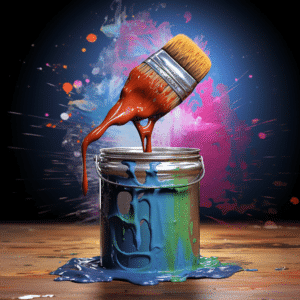Paint Brush Cleaning, and disposing of paint plus paint-related materials appropriately is crucial for environmental and human health reasons. In addition, your septic and plumbing systems are important, and you should watch out for how you use them.
Paint, thinner, turpentine, and other solvents can all cause a fire. Many of the paint compounds are poisonous or emit poisonous fumes. Therefore, paint and other chemicals should be kept away from areas where children or pets can inadvertently smell, touch, sleep or be close when taking food.
Table of Contents
Can You Clean Paint Brushes in the Sink?

Paint Brush Cleaning utilize a public sewer system and use water-based latex paint, cleaning paint brushes in the sink is allowed. However, you need to rinse the sink and drain it thoroughly so as not to leave any detrimental particles or fluid.
You should never clean paint brushes with oil or acrylic paints and paint thinners and solvents in a sink. It’s not advisable to pour paint down the sink or drain, no matter how much it is. Furthermore, paint brushes should never be washed in the dishwasher.
Never clean paint brushes and drain the waste to the septic system, and never dispose of paint brushes or solvents in a septic system. If you have any remaining paint, take it to a hazardous waste disposal center.
What Can Happen if You Clean Paint Brushes in The Sink?
As stated above, you shouldn’t not clean paint brushes on the sink. The practice is not allowed because of the harmful effects that come along when such is done. Human beings, plants, and animals are mostly affected.
Once the paint is in the drain, many dangerous things can happen. First, you must know that paint and paint solvents such as turpentine and thinners are highly flammable. Therefore, you’re risking your home from catching fire.
In addition, the paint materials are known to release highly toxic fumes, which pose a serious threat to the people within and outside the house. The fumes can aggravate allergic conditions such as asthma or other serious respiratory problems.
Acrylic and oil paints can easily form a clot within the plumbing system. When the clot shrinks and hardens, it forms a clog. Therefore, there will be blockage of the plumbing system, and you will be forced to hire an expert to help you solve the problem. That is another expense that could have been avoided.
Considering that all the factors listed above are unsafe. It’s therefore advisable that you avoid cleaning the paint brushes, rollers, buckets, roller trays, or any other paint accessory in the sink. In addition, never attempt to put the same paint items in your dishwasher for cleaning.
What Should You Do If Paint Gets Into The Septic System?
There are ways to fix a septic system that has been damaged by paint. Unfortunately, the hacks aren’t always simple or affordable. You need to be always concerned about how your septic tank is being used.
However, you may find yourself in a situation where paint has drained from the sink into the septic system, and there is nothing you can do to reverse everything. Relax; that is not the end of your septic tank.
You can still salvage your septic system and keep it in the best condition possible. When the paint has gone into your septic tank, the next thing is to know the amount of paint in the system.
Paint Brush Cleaning be too much of an issue if the amount of paint is tiny, such as if it comes from wiping your hands. If too much paint was thrown down the drain, you might need to take more drastic measures. That means you need to empty the septic system sooner.
After emptying the septic completely, you may require the services of specialists to flush the tank and perform “shock treatment.”
Shock treatment involves injecting biological additions into a septic tank through a toilet, sink, or directly into the tank. The biological substance infiltrates a plumbing system with billions of “good” enzymes and bacteria.
The additives should be utilized throughout the duration of a septic system’s lifespan. They aid in ensuring optimal enzymatic levels after being exposed to a harmful substance. Shock therapy is an ideal way of returning the septic system to normalcy.
What Is The Best Way To Clean Your Paint Brush?
If you’re painting with water-based materials, the safest cleaning option is the use of cold soapy water. Fill the container halfway with cold water and a cleaning detergent, then sift the contents.
Apply soap to the paint brush, then immerse it into the solution. Do it several times until a smooth solution is formed. After that, rinse the paint brush with a soft washcloth. Please leave it to air-dry.
How Do You Dispose Water Used In Cleaning The Paint Brush?

Let the dirty paint water settle for a while. After 5- 10 minutes, pour out the solid paint that forms in the bucket’s bottom slowly. Peel the dried paint leftovers when the water in the basin has evaporated and place them in plastic garbage. Next time you’re going to the nearby waste collection centers, carry them with you.
Wrap Up
After every project, proper cleaning of the paint brushes saves you a lot of money. Brushes and other painting instruments may be easily rinsed and ready for reuse. Notably, paint brushes should never be washed in the sink.
The main reason for paint brushes not to be washed in the sink is that a paint solution made from the already used paint brush may damage the septic system. Blockages, contamination, fire, and costly repairs can result even with a little amount of paint draining into the plumbing and septic system.
If you’re using water-based latex paint and utilizing a public sewer line, you can rinse the paint brush in the sink. Make sure the paint is adequately drained and brushed off. Don’t try rinsing the paint brush in the sink if you’ve used oil or acrylic paint.
Paint solvents, thinners, Oil paints, and acrylic paints should all be stored in a safe and secure container. Ultimately, the use of a dishwasher to clean paint brushes is not allowed.


